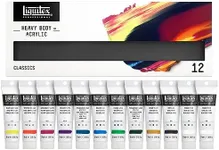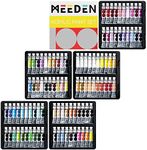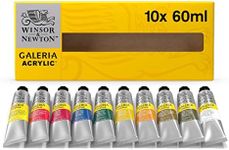Buying Guide for the Best Acrylic Paints
Choosing the right acrylic paints can make a big difference in your art experience, whether you’re a beginner or a more experienced painter. Acrylic paints are popular because they are versatile, quick-drying, and easy to use on many surfaces. When picking acrylic paints, it’s important to consider a few key features that affect how the paint looks, feels, and performs. Understanding these features will help you select paints that match your style, the type of projects you want to do, and your personal preferences.Pigment QualityPigment quality refers to how pure and concentrated the color is in the paint. High-quality pigments give you brighter, more vibrant colors and better coverage, while lower-quality pigments can look dull or require more layers. Paints are often divided into student-grade and artist-grade. Student-grade paints are more affordable and good for practice or casual projects, but they may not be as rich in color. Artist-grade paints have more pigment and are better for professional work or when you want the best color results. If you want your artwork to look vivid and last longer, go for higher pigment quality.
Consistency (Viscosity)Consistency, or viscosity, describes how thick or thin the paint is. Heavy body acrylics are thick and hold brushstrokes well, making them great for textured techniques. Soft body or fluid acrylics are smoother and flow more easily, which is ideal for detailed work, glazing, or pouring. If you like bold, textured effects, choose a thicker paint. If you prefer smooth, even layers or want to mix with other mediums, a softer consistency might suit you better.
OpacityOpacity is about how much the paint covers what’s underneath. Opaque paints hide the surface or previous layers well, while transparent paints let some of the background show through. Some paints are labeled as semi-opaque or semi-transparent. If you want to cover up mistakes or create solid blocks of color, look for more opaque paints. If you enjoy layering colors or creating subtle effects, transparent or semi-transparent paints are a good choice.
LightfastnessLightfastness measures how well the paint resists fading when exposed to light over time. Paints with high lightfastness keep their color longer, which is important if you want your artwork to last or be displayed. Paints are usually rated as excellent, good, or poor in lightfastness. For pieces you want to keep or sell, always choose paints with excellent or good lightfastness.
Drying TimeAcrylic paints dry quickly, but the exact drying time can vary. Some dry in minutes, while others take longer, especially if they are thicker or have special additives. Fast-drying paints are great for quick projects or layering, but they can be harder to blend. Slower-drying paints give you more time to work and blend colors on the canvas. Think about your painting style—if you like to work fast, quick-drying paints are helpful. If you need more time to blend or adjust, look for slower-drying options.
Finish (Sheen)The finish, or sheen, is how shiny or matte the dried paint looks. Acrylics can dry to a matte, satin, or glossy finish. Matte finishes are non-reflective and good for a soft look, while glossy finishes are shiny and make colors pop. Satin is in between. Your choice depends on the look you want for your artwork. If you’re unsure, you can always adjust the finish later with a varnish.



















